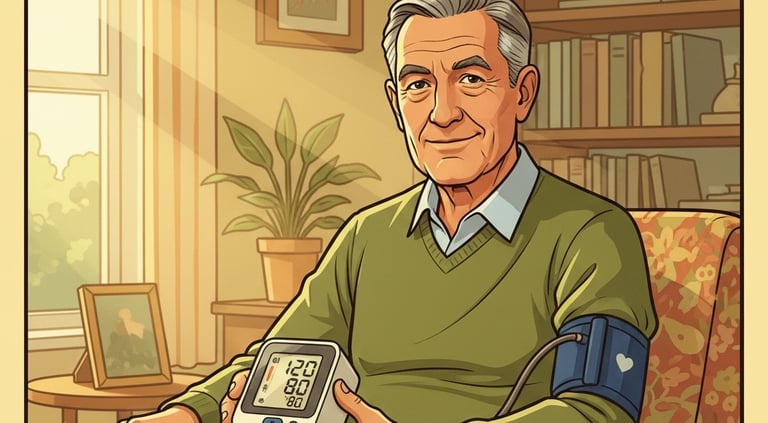FREE AI Analytics Tool for Health Reports and Scans available.
What's the #1 Way for Seniors to Prevent a Stroke?
Discover the single most effective strategy for seniors to prevent a stroke. Learn why controlling blood pressure is key and how simple lifestyle changes and medical management can protect your health.
USEFUL MEDICAL KNOWLEDGE
10/5/20254 min read


Introduction
If you're a senior, or you have a loved one in their golden years, you've probably thought about ways to stay healthy and active for as long as possible. We all want to maintain our independence and quality of life. Among the many health concerns, the risk of a stroke can feel particularly daunting. It’s a serious event that can change everything in an instant.
I remember my own grandmother, who was a force of nature, always in motion, and independent. One day, out of the blue, she had a small stroke. It was a wake-up call for our entire family. We realized that even for someone who seemed so healthy, the risk was very real. Her doctors told us that while age is a factor we can’t change, there's one single thing that could have made the biggest difference in preventing her stroke.
So, what is the single most important thing you or a loved one can do to significantly reduce the risk? The answer isn't a secret pill or a complex routine. It's a number.
The Silent Culprit: The Power of Blood Pressure
The number one way for seniors to prevent a stroke is to control their blood pressure.
That's it. It may not sound dramatic, but it is the single most effective action. Why? Because high blood pressure, or hypertension, is the leading cause of stroke. It’s often called the "silent killer" because it has no symptoms. You can feel perfectly fine while the pressure is quietly and relentlessly damaging your blood vessels.
Over time, this constant pressure weakens and damages the arteries that supply blood to your brain. This can lead to two main types of stroke:
Ischemic stroke: A blood clot forms in a narrowed artery, blocking blood flow to the brain. This accounts for about 87% of all strokes.
Hemorrhagic stroke: A weakened blood vessel in the brain bursts, causing bleeding.
According to the World Stroke Organization, more than half of strokes are directly linked to high blood pressure. It is a risk factor that we have the power to manage.
Your Action Plan: How to Take Control
Controlling blood pressure isn't about being perfect. It's about being consistent. Here's a simple, two-pronged action plan:
1. Lifestyle Changes: Your First Line of Defense
You have more control than you think. Small, daily habits can have a massive impact.
Lifestyle ChangeWhy It Works
Manage Sodium Intake Too much salt causes your body to retain water, which increases blood volume and pressure.
Limit daily sodium to 2,300 mg (about one teaspoon), and ideally, reduce it further to 1,500 mg.
Embrace Regular Movement Even moderate exercise like a brisk walk for 30 minutes a day, 5 days a week, can significantly lower blood pressure. It keeps your heart strong and your arteries flexible.
Focus on a Healthy Diet A diet rich in fruits, vegetables, and whole grains (like the Mediterranean or DASH diet) is packed with nutrients that naturally help lower blood pressure.
Maintain a Healthy WeightExcess weight, especially around the waist, strains the heart and increases blood pressure. Losing just a few pounds can make a big difference.
2. Medical Management: Partner with Your Doctor
This is not a journey you have to take alone. Regular monitoring and professional guidance are key.
Regular Monitoring: The only way to know your blood pressure is to check it. Get a home monitor or use the machines at pharmacies. Keep a log of your readings to share with your doctor.
Medication Adherence: If your doctor has prescribed blood pressure medication, take it exactly as directed. It's easy to forget or skip a dose, but consistency is vital for keeping your numbers in a safe range.
The Big Picture: Beyond Blood Pressure
While blood pressure is the #1 factor, it's part of a larger picture. A holistic approach that addresses other risk factors is crucial.
Managing Diabetes: Diabetes damages blood vessels, making them more prone to blockages. Keeping your blood sugar in a healthy range is non-negotiable.
Controlling Cholesterol: High cholesterol can lead to fatty plaques in arteries. Your doctor can help you manage it through diet and, if necessary, medication.
Recognizing Atrial Fibrillation (AFib): AFib, an irregular heartbeat, is a major stroke risk factor because it can cause blood clots to form in the heart. If you feel palpitations, dizziness, or shortness of breath, talk to your doctor.
The statistics are clear: the American Heart Association reports that over 108 million U.S. adults have high blood pressure, yet only about half have it under control. This single fact underscores why it is the number one target for stroke prevention.
It’s about more than just numbers on a page; it’s about a longer, healthier life. Taking control of your blood pressure is an act of self-care and a gift to yourself and your loved ones. My grandmother, after her stroke, was able to recover well because we all worked together to manage her health. Her number one priority became keeping her blood pressure in check. It's a simple, but life-changing, focus.
Join the conversation: What's one small change you've made to improve your health recently? Share your tips and experiences!
Disclaimer: This article is for informational purposes only and is not a substitute for professional medical advice, diagnosis, or treatment. Always consult with your physician or another qualified healthcare provider before making any health-related decisions.

Address
Blk 8 Cantonment Close
SIngapore